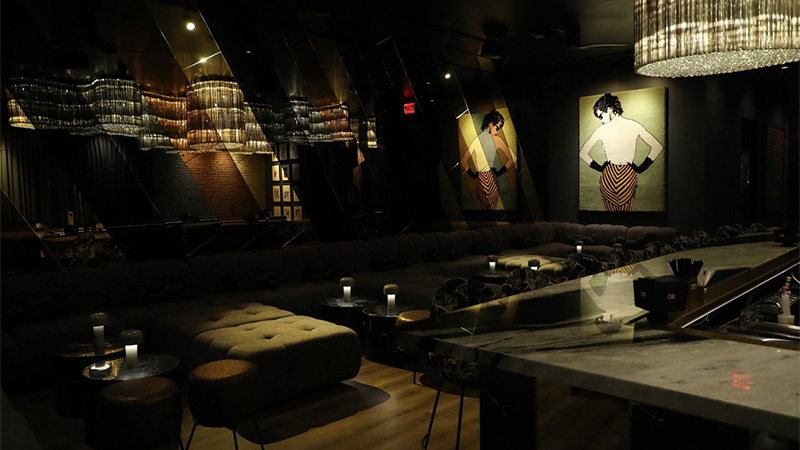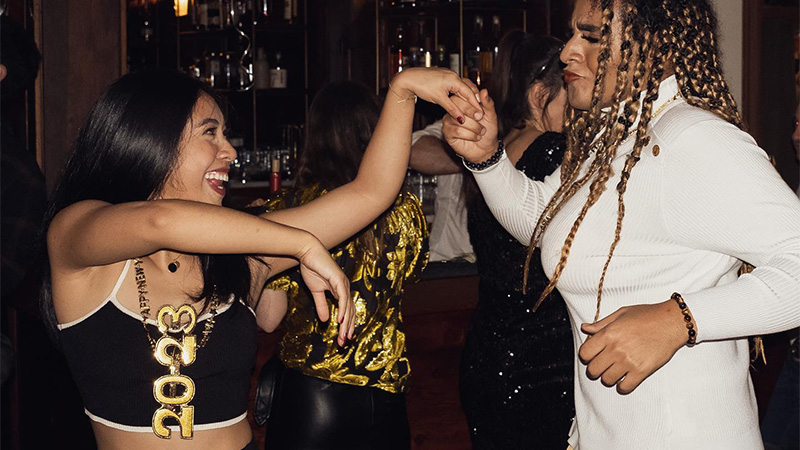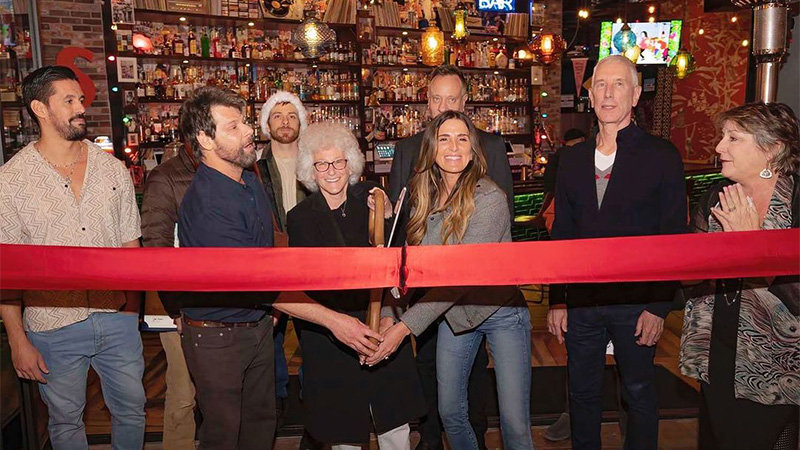If you lived in the Silver Lake neighborhood of Los Angeles in late 1966, you might have walked past the Black Cat in the light of day a dozen times and never suspected it was anything more than an outsized laundromat. For those in the know, it was home to one of the city’s most happening gay bars. By nightfall it often hosted a particularly revelrous crowd. Patrons in attendance weren’t too concerned with the quality of liquid on pour. This scene was much more about camaraderie than cocktails.
“Originally, gay bars were a place where like-minded people could be themselves — often illegally,” says Jay Krymis, owner of the recently opened Schmitty’s in West Hollywood. “These were places where they could safely exist and just simply be.”
Nearly 60 years later they remain a fixture of the community. Yet it’s almost shocking how minimally they’ve evolved in the interim. Even as the modern craft cocktail movement blossomed all around, LGBTQ+ drinkers have largely been denied fanciful tipples. It’s been a long time coming, but a growing band of bar folks are hoping to turn the page on the past, affording a new, proud image for the gay bar. To “simply be” is simply not enough.
Don’t Miss A Drop
Get the latest in beer, wine, and cocktail culture sent straight to your inbox.
IN THE SHADOWS
It once proved too much for eight undercover LAPD officers at the Black Cat, however. Directly after midnight on New Year’s morning 1967 they began physically dragging drinkers from the venue, chasing them out of the bar and beating them with batons on the streets of Sunset Boulevard. The crime? Public lewdness. In other words: they were exchanging kisses and embraces with members of the same sex, in celebration of the holiday.
Outrage reverberated across the community. A little over a month later, more than 200 peaceful demonstrators gathered in a parking lot directly outside the Black Cat and staged what was, at the time, the nation’s largest LGBTQ+ civil rights protest. It preceded New York’s more widely publicized Stonewall Uprising by more than two years.
In the ensuing decades, the slow and steady slog of progress meant that gay bars such as these could position themselves more like any other kind of bar: a venue for boisterous nightlife, as opposed to an unwitting hub for human rights violations. And yet, while it could be convincingly argued that mainstream acceptance of homosexuality was on the rise (concurrent with the concept of high-minded cocktail bars), these seedy dives lagged behind — often confined quite literally to the shadows of society.
“When I was going out, in the mid-‘80s, my first gay bar adventure was a place called L’Amour, which was down a little side alley,” recalls Bradley Tuck, a British expat who works in L.A.’s food and drinks scene. “You knocked on the door and a guy would open a peephole and confirm whether you knew what ‘kind of a bar’ it was. It seemed rather redundant, in my opinion, because who would go knocking on that random closed door at night if they didn’t know?”
Still, it’s not exactly a mistake you’d want to have made in Margaret Thatcher’s Britain. Her Conservative government had just passed Clause 28 in 1987, prohibiting the “promotion of homosexuality” by local authorities.
INTO THE LIGHT
Fast-forward to today, even in a far more accepting environment, like, say, San Francisco’s Castro District, and a stubborn holdover of the past persists. Though the bars are now in plain view, straddling the crowded thoroughfare of Market Street, the craft cocktail movement is nowhere in sight.
Asked if there are any LGBTQ+ establishments that he’d shout out for worthwhile mixology programs, spirits expert Camper English replies tersely: “No.” The author and longtime Bay Area local adds, “There’s a lot less flavored vodka on menus than in the ‘90s, but as much as I’d love for it to be the case that gay bars were keeping pace with the rest of cocktail bars, I guess ultimately the quality of the drinks is not the main draw; it’s more about community and opportunity.”
A cursory scan of drinks lists around San Francisco substantiates the claim. It reveals not much more than light lagers and neutral grain spirit spiked with soda water.

“I think this is due in part to the fact that the queer community — especially BIPOC individuals and women — have not traditionally held the keys to privilege or generational wealth,” according to Austa Somvichian-Clausen, a journalist specializing in hospitality. “This affects both the patrons of queer bars and their owners. Bars slinging Bud Lights and well spirits all night are going to make a much larger nightly profit margin than a bar serving cocktails that take time to produce and cost more for the establishment, especially factoring in labor.”
It certainly affected the way that Somvichian-Clausen experienced nightlife in her home city of New York. As she describes, there was a huge gap in the space for a bar that provides more of a sit-down option for the community — where they could either catch up with friends or go out on date night without having to contend with lines and loud music. They deserve a place where they could have “nice things,” she reasoned, including well-conceived cocktails. So she opted to take matters into her own hands and in January opened up grotto, a pop-up bar inside the Ludlow House in the Lower East Side of Manhattan.
“The grotto is a sapphic cocktail bar concept, meaning its primary focus is serving WLW [women loving women] members of the LGBTQ+ community,” Somvichian-Clausen explains. “Another tenet of grotto is providing a safe and inclusive space for trans and non-binary folks, who typically get left out of the equation of your typical gay bar.”
Somvichian-Clausen conceived the cocktails, which include mezcal-based Espresso Martinis, and bourbon drinks jazzed up with fig and vanilla. They’re all served in a tranquil setting, featuring a fireplace and an elegant decor designed by her partner, who holds a background in professional art.
“Anyone who spends time at grotto can feel the difference of being there; it feels warm, like you can let out a breath,” adds Somvichian-Clausen. “And we are so fueled to continue progressing the concept when we see queer couples all sitting together on the same side of the booth, finally feeling like they can show PDA to one another without fear of fetishization or judgement from the other patrons.”

That sort of vibe isn’t cultivated sheerly by chance, either. The bar’s booking system allows guests to select how garrulous they feel like getting on any given night. If seating allows, they’ll mix groups together at a larger table, or place singles by the fireplace. The dynamic concept has been a resounding success. Though the pop-up was initially intended to last through the end of February, it has now been extended through April. Eventually, the couple would like to find a permanent home for grotto.
COCKTAIL SUBCULTURE
Meanwhile, back on the opposite end of the country, Los Angeles is quietly building its bonafides as the epicenter of this gay bar reinvention. Schmitty’s is just the latest piece of evidence. Here you can enjoy an artfully rendered “cock”tail: Japanese whisky stirred with Demerara and peach bitters, and adorned with a vintage nude photo of an aroused male model. It’s a sex-positive spin on an Old Fashioned.
“We wanted to provide West Hollywood and the L.A. queer community with a true neighborhood bar,” says Krymis. “This is a gathering place to grab a drink before you hit the clubs. You will not find a go-go dancer in front of your face, but you may find a piano singalong or a rolling magician.” And also — as one fan on Instagram enthusiastically notes — comfortable bar stools.

Several blocks up Santa Monica Boulevard, George Kotsiopoulos is offering more than mere comfort at his cocktail lounge, Or Bar. He’s serving all the pomp and circumstance expected of modern mixology, including the per-drink price tags. Negronis are stirred with craft gin from France, on pour for $22. The Liberace is $2 more and combines Calvados and Armagnac with toasted coconut.
“Stylistically and musically, most gay bars haven’t changed much in the last 25 to 30 years,” notes the entrepreneur and frequent television host. “It’s the same decor, the same videos playing on the walls, etc. There’s been no place ‘nice’ to go to, especially for people in their 30s and beyond. And that’s the reason why we created Or Bar.”
Kotsiopoulos is quick to point out that this interior evolution wouldn’t have been possible without what was going on externally. Namely: being gay became more and more normalized. He credits ‘90s-era entertainment, including “Will & Grace” and “Sex and the City” with convincing every straight woman to seek out their own gay BFF. This directly precipitated a straight “infiltration” of the gay bar in the early aughts.
“It’s now become a safe place for some straight women to cut loose and (mis)behave in ways they would not at straight bars,” he says. “This was mostly OK until the bachelorette parties came and took over to the point where now many gay spaces have a ‘no bachelorette party’ rule.”
Today, in any sizable city across the country, a plethora of venues exist as “gay friendly.” You’ll recognize them, of course, by the rainbow flags hovering conspicuously above their entryways. But they’re not explicitly gay bars per se. And as Kotsiopoulos notes, it’s lead some to suggest that as LGBTQ+ has become “more accepted,” the very concept of an explicitly gay bar is obsolete.
“I say more accepted because unfortunately the world still has a problem with gays and lesbians,” he adds. “So long as that’s the case, safe spaces are still necessary for the community.”
Thankfully, Kotsiopoulous and his West Hollywood neighbors are doing their part to promote those spaces mere miles west of where the Black Cat once hid, in plain sight. Much has changed since that fateful New Year’s night in Silver Lake, and there is undoubtedly more progress to affect. In the meantime, contemporary queers can enjoy drinks in a novel setting. It’s not a gay bar where you need to be. It’s the gay bar where you want to be.